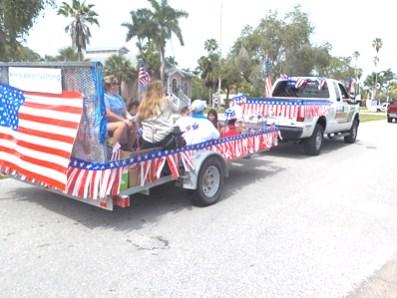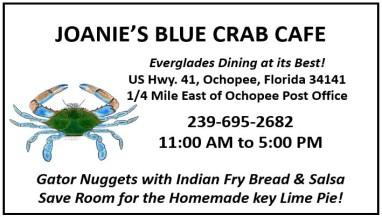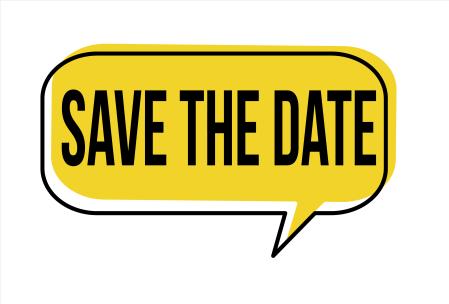The MULLET RAPPER
What’s Happening in the Everglades & 10,000 Islands
Living Gulf Coast by Charles Sobczak American Crocodile (Crocodylus acutus) Other names: American croc, saltwater croc, salty, croc / Status: FL=threatened, IUCN=VU / Length: 9.8-13 ft (3-4 m) / Weight: 380-840 lb (173-382 kg) / Life span: to 70 years / Reproduces: Along the southern edge of Florida, mostly in Monroe County / Found: Lee and Collier counties, coastal / Months found: (lower case indicated nesting season) JFMamjjasOND. The crocodile is a rare sighting in Southwest Florida. Extremely vulnerable to cold temperatures, it seldom ranges as far north as Lee County, with the vast majority of the region’s sparse population living along the southern coastal edge of Collier County, predominantly in the Ten Thousand Islands and Everglades National Park. Because this region represents the northern edge of its range, the Florida croc seldom grows as large as those found farther south. In South America there have been official reports of 20foot crocs. The longest croc skull ever measured was 28.6 inches (72.6 cm) and came from a mature male estimated to be at least 22 feet long. That animal would have weighed more than 3,000 pounds. A crocodile this size could eat a horse. Whole. Sadly, because of over-harvesting and hunting, the American crocodile is in trouble throughout its range. Venezuela banned the taking of crocodiles in 1972. Other nations such as Costa Rica and Cuba have followed suit, and in these locales the croc is making a slow but steady recovery from the brink of extinction. Ironically, a major reason for the recovery of the American crocodile in Florida, where its numbers are now estimated at more than 1,500, is the nuclear power plant at Turkey Point, built in 1972 south of Miami near Homestead. The power plant encompasses some 3,300 acres of wetlands through which a series of canals were dug to assist in cooling the water used to keep the reactor core from overheating. Shortly thereafter, a handful of American crocodiles discovered these canals, which teemed with fish that thrived in the artificially warmed waters. Like the endangered manatee that frequents the Florida Power and Light plant in North Fort Myers at Manatee Park, the Florida croc has found a safe haven at Turkey Point. The power plant has become the primary recovery engine for the entire Florida population, helping to upgrade the status of this impressive animal from endangered to threatened in 2007. Despite its size, the crocodile is far less aggressive than the alligator toward humans. Aside from an injured croc named Zulu that killed the man who shot him in 1925 on the outskirts of Miami, there has never been a confirmed attack by any crocodile in the U.S., though there have been several fatal attacks reported in Mexico and Central America. You should never approach a crocodile in the wild. If its nest is anywhere near, the female crocodile will kill in defense of its eggs. The croc, like the alligator, is capable of explosive charges that occur almost faster than the human eye can follow. In the water the croc can obtain speeds of 20 miles per hour and is capable of launching its 2,000-pound body completely out of the water with its powerful tail. Charles Sobczak is an author and photographer that lives on Sanibel Island. His books are available on Amazon, and other online booksellers.
May 15, 2021 Fishing the 10,000 Islands With Captain Mike Merritt
Well, it feels like summer is here! Thankfully, there should be fewer boats on the water - and the fishing is getting better! Snook fishing on the outside is good in between the windy fronts. There are plenty of big Snook roaming the outside Islands and the early mornings and late afternoons should be best. I love throwing top water this time of year and Zara Spooks are my favorite. There is nothing like a big Snook blowing up your top water lures! There are still plenty of smaller Snook too, and these will take jigs readily. Live bait is a sure way to get plenty of action this time of year too. How you hook your baits can determine the action you get. Depending on current speed, water depth and how active the feed is, will determine where you hook the bait. I am surprised to find how many of my clients don't know the difference in how and why we hook baits a certain way. Just remember, the same thing doesn't always work. Don't be afraid to change things up. The Reds are still around but still scarce as compared to earlier months. The ones we are catching are scattered out. I haven't been on a school of Reds for 2 months. We did get a couple good ones on top water in the backcountry but these are scattered also. The jigs seem to be working the best. Tarpon fishing has been tough with the winds, but there are lots of fish around. Depending on the winds, you can find them along the outside islands and even in the back bays. Hopefully the winds lay down and they will be easier to locate! With temperatures rising getting an earlier start can pay big dividends. The incoming tides will generally be the best feed on the outside islands. Make sure to handle the Snook with care as they are getting ready to spawn. Also if there are Sharks in the area you may have to leave those fish alone or the Sharks will ruin your day. Remember to hydrate well and have a great time enjoying our great fishing! Capt. Mike Merritt
Fish With Captain Mike Merritt 561-252-4324 or email SnookFishing1@juno.com
~~~~~~~~~~~~~~~~~~~~~~~~~~~~~~~~~~~ ~~~~~~~~~~~~~~~~~~~~~~~~~~~~~~~~~~~ Get The Tides For Your Next Trip
There is a great tide tool on the VisitEvergladesCity.com website. You can select by specific area (“Lostmans”) and get the tide data for current and future dates. You also get sunrise, sunset and moon rise and set data, in addition to night illumination percentages. This data is very useful for fishing, boating and planning paddling trips...and it is FREE! Get Tides, Download Regulations: www.VisitEvergladesCity.com/tides www.VisitEvergladesCity.com/fishing
email: mulletrapper@gmail.com
PAGE 5
www.visitevergladescity.com






